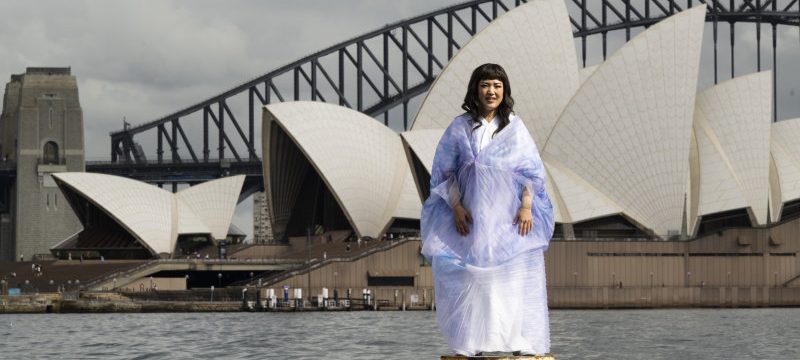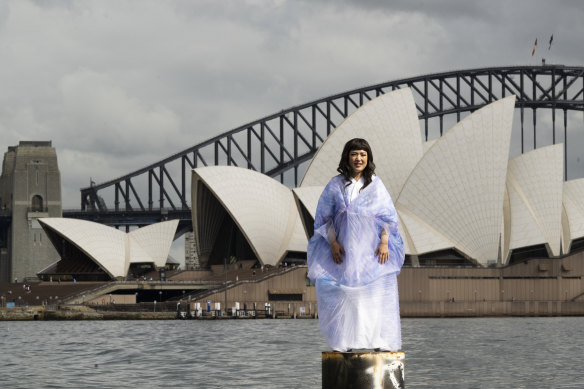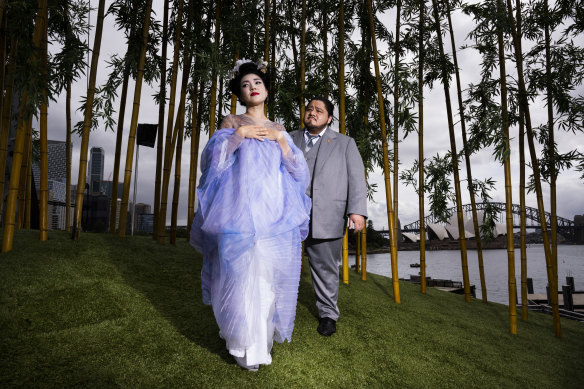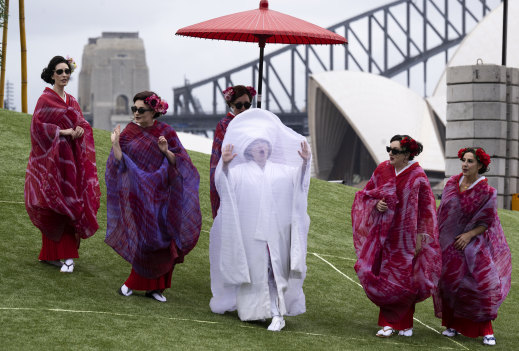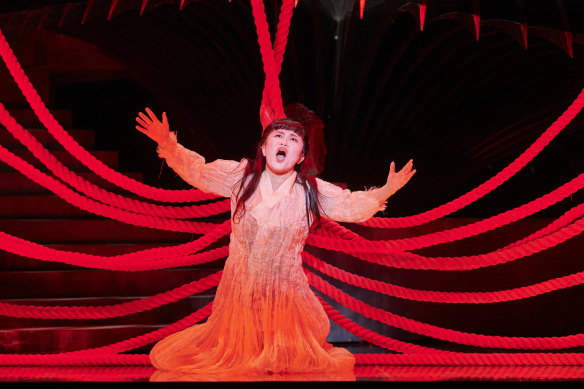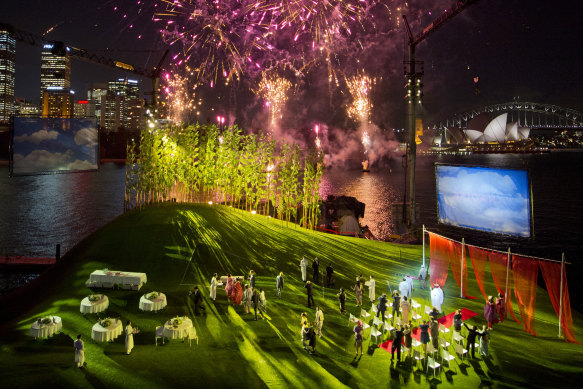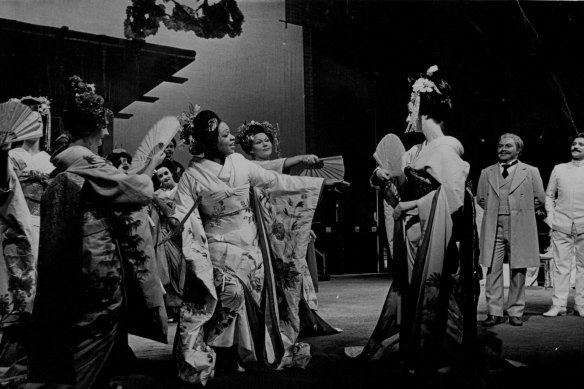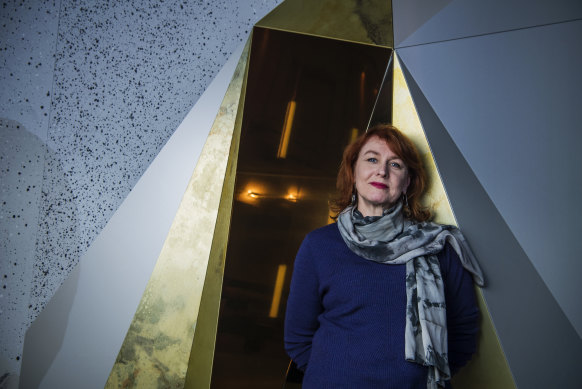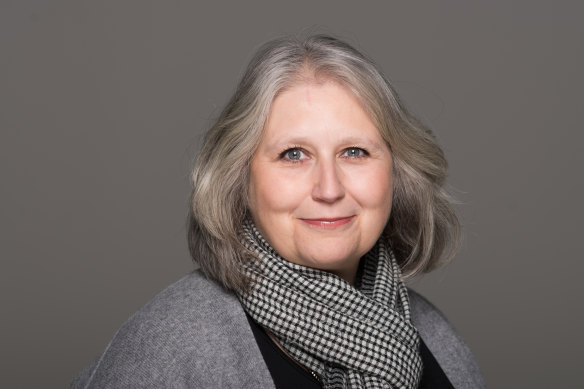By Nick Galvin
Soprano Karah Son will play the role of Cio-Cio-San in the latest Opera Australia production of Madama Butterfly Credit:Louise Kennerley
Dozens of productions of Madama Butterfly are staged around the world each year. Massively popular among aficionados and newcomers alike, Puccini’s 1904 work is also much beloved by opera companies who know they can rely on it to fill seats and coffers.
And that includes Opera Australia, whose latest season of Madama Butterfly opens on Friday night on the over-water stage at Mrs Macquaries Point, its second staging of the opera in less than two years.
But as well as being a bankable favourite with a score of ravishing beauty, Madama Butterfly is also deeply problematic. It combines cultural appropriation with a plot dripping in misogyny and exploitation, making it emblematic of the challenges facing all opera companies with a core repertoire that frequently revolves around stories in which female characters are brutalised and killed.
Karah Son (Cio-Cio-San) and Diego Torre (Pinkerton) during costume rehearsals for Madama Butterfly.Credit:Louise Kennerley
In Butterfly a 30-something, well-heeled American tourist cynically manipulates a naive 15-year-old Japanese girl into believing they are legally married in order to sexually exploit her. After she becomes pregnant he deserts her, returning three years later with his “real” American wife and persuades the girl to give up her son. Distraught at being abandoned and losing her child, the teenager stabs herself to death.
How should a story like Butterfly be presented? Should it even be removed from the repertoire entirely, along with Tosca (she kills herself), Carmen (she is murdered), Aida (she dies), Don Giovanni (he is a rapist) and many others?
And while Cio-Cio-San (Butterfly) is sung in this production by two performers of Korean background – Karah Son and Eva Kong – other productions of Madama Butterfly have long been dogged by accusations of inappropriate cultural representation. Opera Australia too has had to reckon with the subject.
Opera Australia, too, has had to reckon with its role. The company was accused of “yellowface” after casting white performers to play characters Ping, Pang and Pong in last year’s Turandot, it was also criticised for non-Hispanic singers taking lead roles in 2019’s West Side Story. Opera Australia courted controversy again when it announced a season in August of Miss Saigon, a production long criticised and boycotted for perpetuating racialised stereotypes.
Dr Caitlin Vincent, Head of Arts and Cultural Management at the University of Melbourne, is one of the many voices contributing to this discussion as opera companies struggle to fit the art form for the 21st century.
Karah Son (Cio-Cio-San) and members of the cast during costume rehearsals for Madama Butterfly.Credit:Louise Kennerley
“These operas are historical artefacts,” she says. “They are a reflection of a particular time. The operatic canon is often described as a museum repertory. They are a reflection of the worldview of their creators who happened to be white European men who maybe had never actually been to a lot of the seemingly exotic places they were writing about.
“Ethnic exoticism was very popular at the time and a lot of the characteristics of grand opera really lent themselves to the idea of having elephants on stage and travelling to far away lands. The way women are characterised, the way people of colour are characterised is all very much accurate to those time periods.”
Sae-Kyung Rim as Cio-Cio-San in Opera Australia’s 2022 production of Madama Butterfly at the Sydney Opera House.Credit:Guy Davies
However, while Madama Butterfly is undoubtedly a product of the attitudes and prejudices of its time, like all theatre it is almost infinitely malleable.
“Operas aren’t a fixed text,” says Vincent. “They only exist when they have been interpreted on stage. And that interpreting is being done right now by living people who are choosing how they’re going to deal with these outdated elements.”
Sydney-born director Lindy Hume has long specialised in shining a contemporary light on many of the classics in the opera repertoire. Recently, she was appointed interim creative director at Opera Australia until the new, permanent appointee, Jo Davies, officially takes up the position in November.
“You have to take these operas and look at them through the lens of the society in which the audience exists,” she says. “If you don’t do that you’re not doing what theatre needs to do.”
In 2021, Hume directed Madama Butterfly for Welsh National Opera (WNO). It replaced a well-loved version from 1978 that had over time become “a bit of a lounge chair of a production”.
For Hume, audiences must be challenged by the cruelty inflicted on Cio-Cio-San and never become lulled into being comfortable by the familiar narrative and music.
The 2014 Handa Opera on the Harbour production of Madama Butterfly.
“People need a bit of a shock to look again at how completely repulsive the story is. It’s so misogynistic and callous. If they just think, ‘Oh, isn’t it romantic’, they are not getting the point. It’s a brutal story, a grubby story and a shocking story. If it loses that element of cruelty and almost voyeurism it hasn’t done its job because I do believe that is implicit in the work.”
For her well-reviewed WNO Madama Butterfly, Hume minimalised the Japanese romanticism, setting the story instead in a more imaginary, dystopic setting that allowed the focus to shift to the way Cio-Cio-San is brutalised by the men around her.
“My thought was let’s just focus on the 15-year-old being sold into a pretend marriage and go from there,” she says.
Hume also points out that, as distasteful as the storyline is, sexual slavery and trafficking young women continues to be shockingly common in the 21st century. In that sense, Madama Butterfly has plenty of contemporary relevance.
Hume has praise for the current Opera Australia production, which although very different from her own, also brings an unflinching focus to the story. This production is a remount of a production from La Fura dels Baus, a Barcelona-based theatrical group, led by artistic director Alex Olle, which premiered on the harbour in 2014.
“I think they have done a really good job,” says Hume. “I think of all the Opera on the Harbour presentations that is the one that most interestingly engages not only with the site but also the tough stuff of this particular opera. It would be so easy to just do the spectacle but they do a great job of undermining or subverting that expectation but still giving a terrific show to those audiences.”
For this production, OA has employed Sydney-based Japanese actor and theatre-maker Mayu Iwasaki as a cultural consultant. She has focused on all the details of how Japanese culture is represented down to the smallest prop. Some Japanese audience members could find seeing something inaccurate on stage – a movement or the length of a kimono – deeply offensive.
“You feel it in your body if it it not represented right,” she says. “I feel like [bringing in a consultant] is a first step and a good step. I won’t say it’s a comfortable story but I need the challenge of asking questions.”
Iwasaki also points out that the ugly fetishisation of Asian women in Madama Butterfly by western men remains a problem in contemporary culture.
“We can’t shy away from the fact that it is still happening,” she says.
The Australian Opera’s 1977 production of Madama Butterfly.Credit:Bill Moseley
The shift towards contextualising and interrogating “problem” operas such as Madama Butterfly, however, is not without its critics. Traditionalists typically prefer companies not “tamper” with the works. This can leave opera companies, who need to fill theatres while also appealing to a younger more culturally aware audience, with an acute dilemma.
“You have this rift between different kinds of audiences,” says Vincent. “I feel very sympathetic to opera companies who have to try and balance between these two audiences. In many cases the really conservative audience members who want to see those traditional productions are the ones buying subscriptions and donating. Can companies – especially state-funded companies – afford to be so restrictive on who they are actually appealing to?”
But for systemic change to happen on the stage it is widely agreed opera companies need to get their own houses in order. Worldwide, the creative roles in opera companies -– conductors, directors, composers, designers – are overwhelmingly dominated by men. And the core repertoire is composed of works exclusively written by men.
Consider the fact New York’s Metropolitan Opera staged a work by a female composer in 1903 and then it took 113 years for another work by a woman to make it to the Lincoln Center stage.
In an essay five years ago, Hume defined the problem succinctly.
“Despite a large female audience, opera is controlled largely by middle-aged blokes who commission other blokes to direct, conduct and design operas composed by dead white men,” she wrote. “Some of my favourite composers are dead white men, but the world has changed. There are countless excellent women composers. There are no excuses for the industry’s casual bias.”
This wild gender imbalance affects what stories are told and how they are told.
“Women have a very difficult time accessing conducting and directing roles that actually help shape interpretations,” says Vincent. “We run into trouble when a particularly homogenous group of directors and designers chooses to lean into the traditional way in which some of these works have been done.
“And in the opera world we’ve also had a lot of issues with sexual harassment and misconduct with men in very high artistic leadership roles. So you have all these abuses happening behind the scenes and you have a lack of representation in employment and then we’re seeing women getting raped and murdered on stage. Is that really the best we can do?”
Lindy HumeCredit:Louise Kennerley
Currently, women make up only about 15 per cent of creative teams at Opera Australia. However, the winds of change are blowing fiercely through our national company which, for the first time in its history has two women at the very top of its management structure, making it unique among other companies globally of comparable size.
In mid-2021 Fiona Allan was appointed chief executive and then at the end of last year, following the departure of long-time artistic director Lyndon Terracini, Jo Davies was named artistic director.
Allen says she is committed to achieving gender equity at OA in the most visible and influential creative positions as well as commissioning and performing more work by female composers.
“We can’t escape the opera canon,” she says. “But we can make sure there is more balance in the stories we tell. It’s not just what is the story and how does it end. It’s who’s doing the storytelling. What I can absolutely commit to is looking at balance in creative teams. Historically, we’ve predominantly had male conductors and sometimes all-male creative teams which I find quite astonishing in this day and age.”
However, she was unwilling to commit to a firm target or date.
Jo Davies will start in her new role next year.Credit:Kirstie Young
“Audiences will see significant progress towards gender balance in creative teams from Lindy Hume’s summer 2024 season, due to be announced in the coming months,” she said in a written statement.
And, as to whether it was time for a new Madama Butterfly at OA, she said that was a matter for discussion with Davies when she arrives.
Vincent says there may come a time when some works disappear from the repertoire but in the meantime there is plenty of scope for opera to change with the times.
“There is a lot of talk that we need to cancel the canon and maybe we will eventually think some of these works are just too far at odds with modern social thought,” she says. “But I don’t think we have to do that yet until we try having stronger representation for women and people of colour.”
A cultural guide to going out and loving your city. Sign up to our Culture Fix newsletter here.
To read more from Spectrum, visit our page here.
Most Viewed in Culture
Source: Read Full Article
